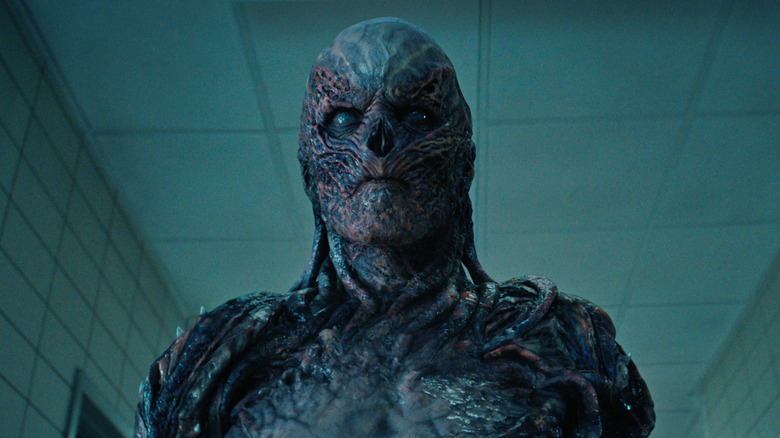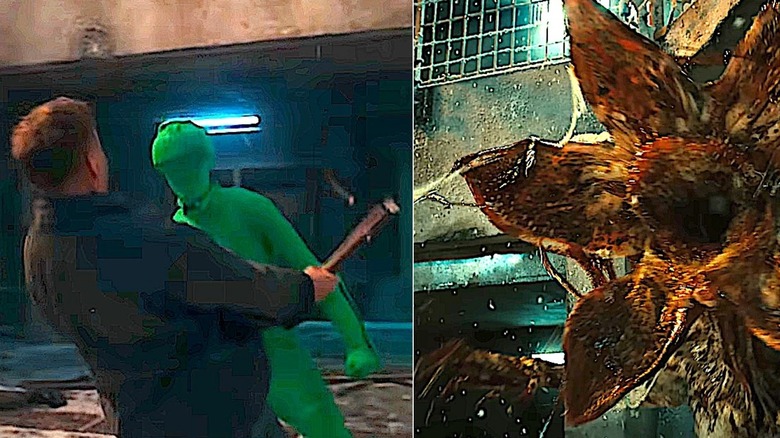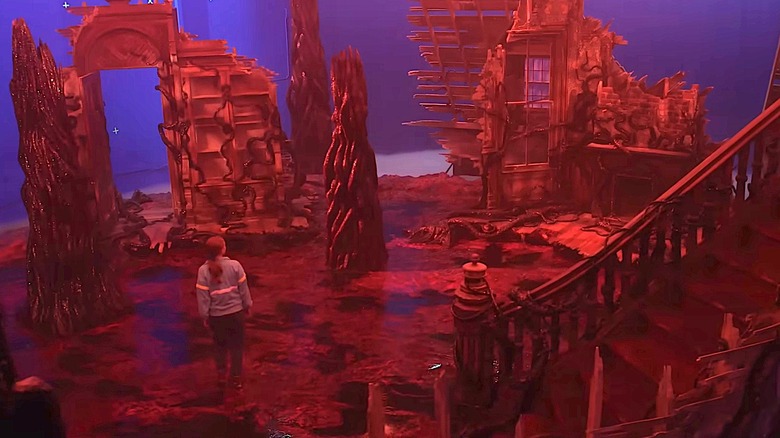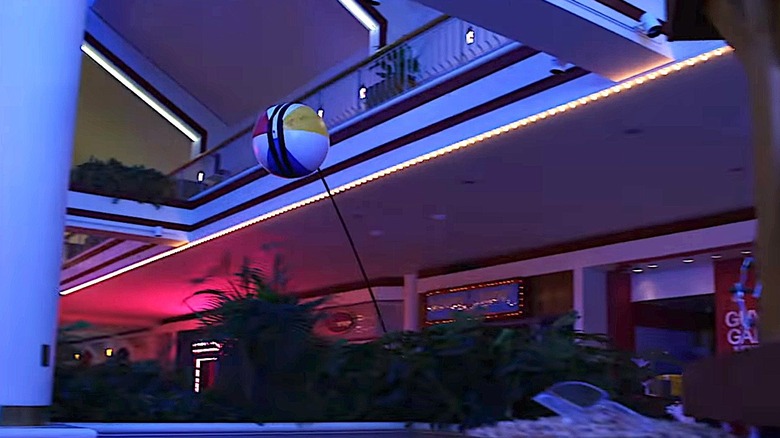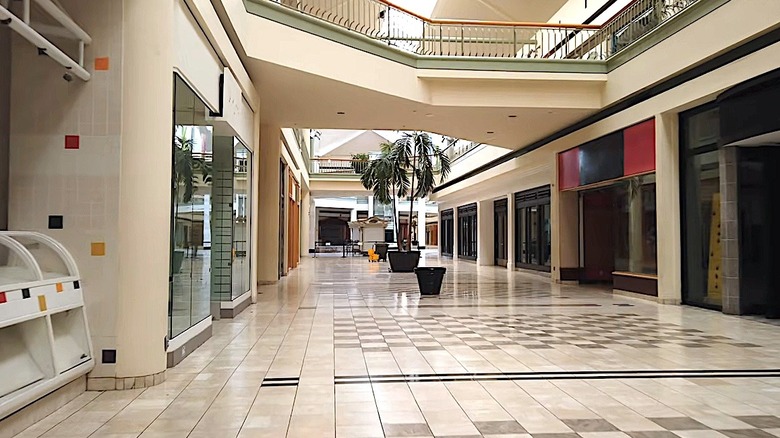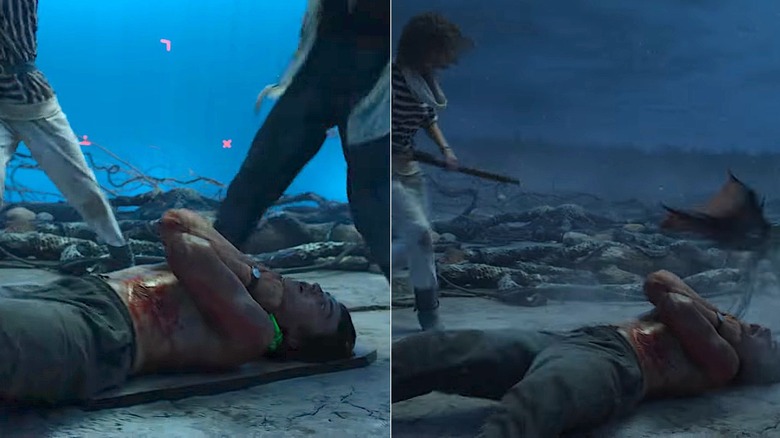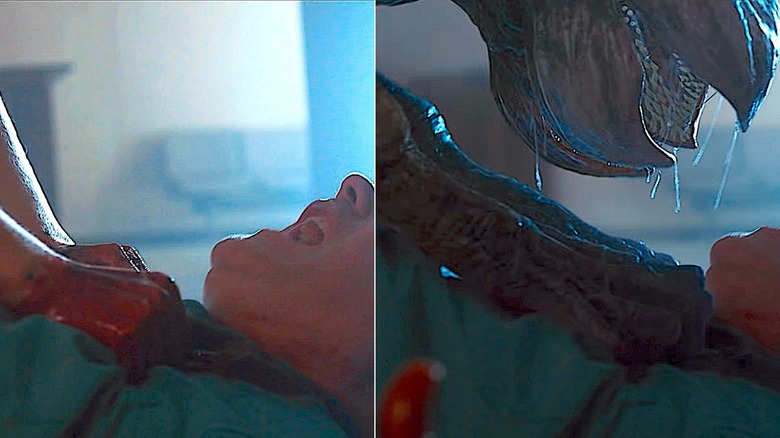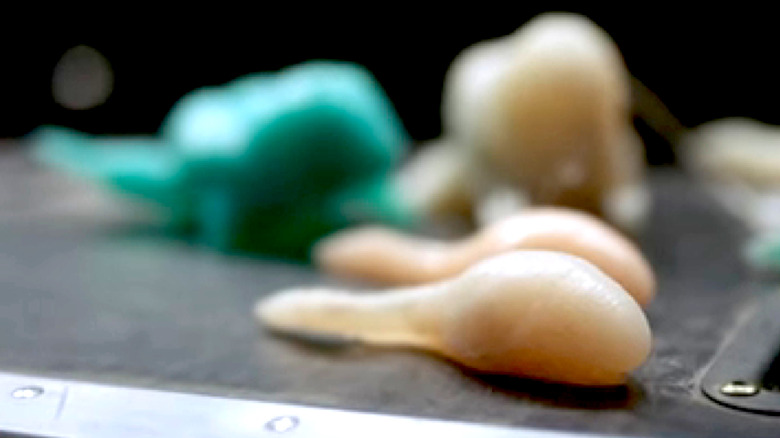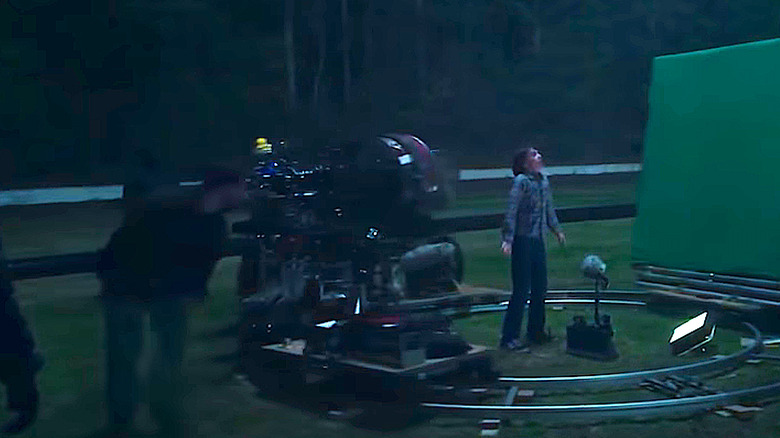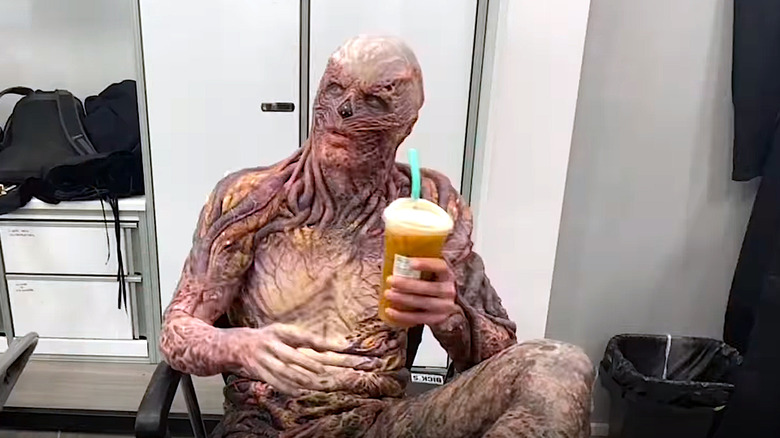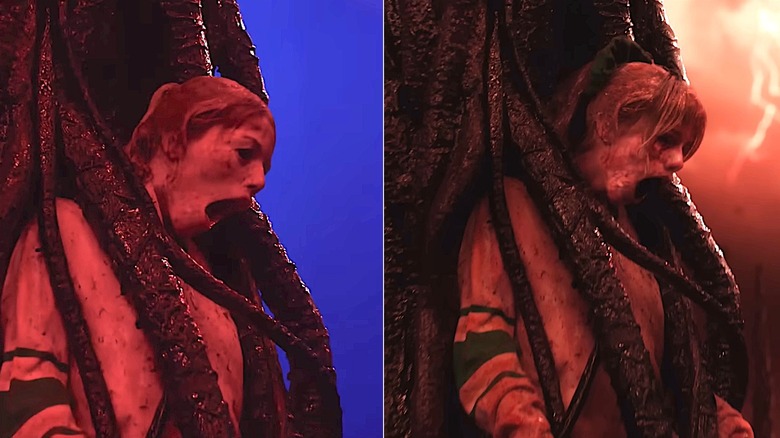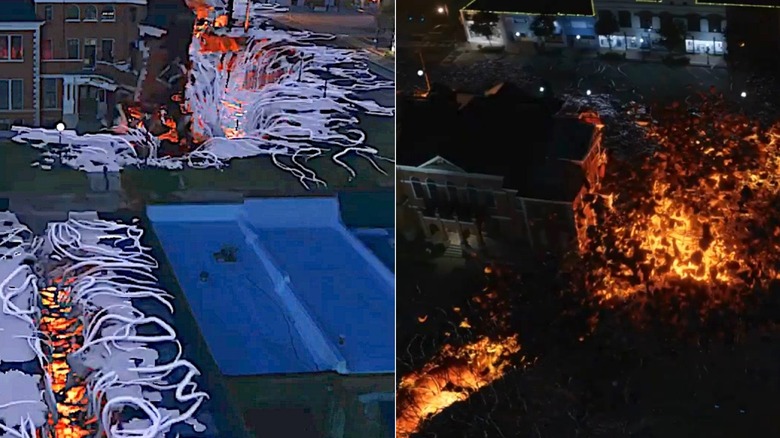What Stranger Things Looks Like Without Special Effects
"Stranger Things" is a family horror show that has evolved from a low-budget but stylish Steven Spielberg-meets-Stephen King creature feature to a global smash success — with an effects budget and expansive design team to match.
Going into its fifth and final season, "Stranger Things" has steadily evolved in terms of storytelling scope and visual effects artistry. Creatures that were kept in relatively cheap shadows in Season 1 are shown in full, well-lit movement by Season 4. The show's effects process has gone from largely practical effects in Season 1 to a mix of grand-scale practical effects and CGI manipulation in Season 4 and beyond.
The Duffer brothers' heartfelt and horrific show about kids on bikes fighting through trauma to take down powerful evil together has come a long way since the first flicker of tangled Christmas lights. Let's peer a little closer into the Upside Down, and learn what "Stranger Things" looks like without special effects.
The Demogorgon uses multiple effects to come to life
In Season 1, the Demogorgon monster was achieved with a man in a suit, kept mostly in shadow. But as "Stranger Things" budgets and effects teams expanded, so too did the possibilities for rendering the Demogorgon. Jim Hopper (David Harbour) battles a partly-CG, partly-practical version in the snowy Russian prison yard of Season 4.
According to the Duffer brothers in a Behind the FX featurette for Netflix, this Demogorgon is no man in a suit — but an animated creature. "The first animation pass, that's when you're seeing what almost looks like just a gray, clay rendering," Ross Duffer explains in the video. "Then ... they get the skin, they get the snow, the lighting." To give this new and improved Demogorgon his close-up, the Duffers worked with their visual effects team to create the illusion of a "oner," a scene captured in a single, continuous take — but with movie (and monster) magic, this "Stranger Things" "oner" is maybe more like a "fiver."
The team shot two versions of the stunt sequences: one with a man in a green suit as the Demogorgon, and one "clean" version with no green man. In post-production, RodeoFX dropped in their animated Demogorgon accordingly. The sequence's effects were also impacted by a pitch Harbour had for the big fight. According to the Duffers, Hopper was originally just supposed to jab at the Demogorgon's mouth. Instead, Matt says, Harbour suggested he "throw this sucker like a javelin." Everyone's happy he did — except, of course, the Demogorgon.
The Running Up That Hill sequence
Emotions run high in Season 4 — and Max Mayfield (Sadie Sink) runs even harder. When Max is sucked into Vecna's (Jamie Campbell Bower) Mind Lair, she discovers a red island full of blood, smoke, and some of her dead friends. The hellscape is located inside Vecna's mind. The healing powers of friendship and music punch a portal through Vecna's prison, and Max runs for it — and up that hill — to break free.
The art department constructed a platform set complete with key practical elements for Sink to interact with, like Chrissy's dead body in the tree and the winding wooden staircase from the Creel House. The floor really was covered in "blood," which Sink herself navigated. "There was like, a rope tied to my ankle, and then dragged me across the floor," Sink says in a Still Watching Netflix featurette. "But the vines when I'm like ... [being strangled], none of that was there. So that was kind of just like, strain my arms and my neck to make it look like there was something wrapped around them."
Sink's stunt double took drastic running falls into the liquid, and the two performances were later stitched together into the final (terrifying) product. Key areas of the set were dressed with blue screens, so that the set could be further extended and manipulated by the visual effects team. The sequence combines digital creations and practical effects to make Max's heart-pounding race to Kate Bush's power jam emotionally impactful — and visually stunning.
The Mind Flayer
Season 3's Mind Flayer gave "Stranger Things" fans a whole new look at a good old shadow monster — and the sheer destruction it could reap after a few years of good eatin' on rats, people, and psychic links. Earlier iterations of the spidery Mind Flayer were smoky and particle-based, but the monster was due for a makeover for Season 3 and the big showdown at Starcourt Mall.
"They started off with a rough idea: We want this thing to come to life as a small pile of goo, which is essentially a rat being flipped inside-out," RodeoFX's Martin Pelletier told IndieWire. "And this thing is going to grow by the very end into a giant monster that is 20 feet tall." The Duffers and their team were inspired by the creepy-crawly alien flesh depicted in John Carpenter's "The Thing." They were also into replicating some of the old-school ways those effects were pulled off: covering practical limbs in gobs of slime.
Instead of actual slime, the monster's drip was created and texturized digitally, and mapped over a CGI animation rig that could be adjusted based on what scene the monster was needed for. In the meantime, they used a beach ball on a stick as a reference for actors and animators. RodeoFX fine-tuned the 22-foot-tall creature from there. Even their previsualization animation for The Mind Flayer and Starcourt battle is terrifying.
Mall madness
Back in the '80s, people didn't buy everything online. Sometimes they went to a place called "The Mall": a shopping palace full of fountain soda, food courts, and funky knitwear. The Duffer brothers know the power of "The Mall" and of nostalgia, and put both on full display in "Stranger Things" Season 3. If Starcourt Mall, stuffed with stores like The Gap and Scoops Ahoy, looks like it was made with impeccable CGI, well — it wasn't. Not entirely, anyway.
Production designer Chris Trujillo actually found a mostly-vacant suburban Atlanta mall and used it as the base set for Season 3's big adventures. Gwinnett Place Mall was a so-called dead mall when the "Stranger Things" crew rolled in. Trujillo and team physically built out much of the two-story, totally '80s atrium space. "We had to painstakingly re-create the facades, all of the signage, all of the storefront displays," Trujillo told the Los Angeles Times. Trujillo's team also created the Scoops Ahoy set, telling the Times, "It was our special little baby."
The team also stocked stores that were never even shown in the series, in order to give the appearance of a working mall — and let the Duffers make creative choices on the fly. This practical magic, plus RodeoFX's digital modeling and painting of the environments, created a final result that was totally radical. Throw in the terrifying Mind Flayer, and these effects gave new meaning to the phrase "shop til you drop."
Demobat out of hell
The Demobats are new to Season 4 of "Stranger Things." These demon bats, equipped with creepy tendrils, preternatural strength, and bloodlust, have quickly established themselves as enemies to all that is good in Hawkins — as well as one of the show's most intense visual effects challenges yet.
Steve (Joe Keery), Nancy (Natalia Dyer), Eddie (Joseph Quinn), and Robin (Maya Hawke) battle the Demobats in Season 4, Episode 7 — though that's certainly not the last Eddie sees of them. During the bloody, brutal battle, Steve manages to take a bite out of a bat. This wins him major Ozzy Osbourne points with Eddie — and also illustrates just how wildly complicated the effects work is for these scenes. Multiple VFX vendors worked on "Stranger Things" Season 4, and RodeoFX and DNEG put their heads together to make the Demobats fly.
"Our main goal was to make sure we could cover all possible actions with its anatomy," RodeoFX's Julien Hery told VFX Voice. DNEG team members also described how the Demobat battle in Episode 7 involved digitally stitching and painting five plates, or shots, together, while accounting for the four human actors working against blue screen, the three Demobats fighting them, and a digitally extended Upside Down. Not to mention, the camera keeps pace with the fight and moves fluidly throughout the scene. We imagine this level of complexity is enough to drive any VFX specialist batty — but it also drives viewers wild.
Bob's death by Demodog
If a good dude volunteers to reset the breakers in a horror show so that everyone else can escape, chances are it's curtains for him. "Stranger Things" sure knows its way around a devastating death, and sweet Bob's (Sean Astin) death by Demodog in Season 2 is about as devastating as they come. The Demodog is like a teenage Demogorgon, and behaves about as badly as you think a teenage death-monster would.
Bob almost gets away from the Demodog pack that's invaded Hawkins Lab. Even after he draws attention to himself by dropping a stick, he's able to flee to safety behind a locked door. Too bad doors are nothing to a Demodog on the prowl. Bob gets gutted by the beast, and it shows no mercy. The final image of the Demodog is all CGI, created under the VFX supervision of Season 2's husband and wife team, Paul and Christina Graff.
However, since the struggle between Bob and the Demodog is very real, a stand-in was needed for Astin to interact with. Some of this was achieved with the classic CGI trick of putting a tennis ball on a stick and poking Astin with it. But the more interactive fighting stand-in wasn't a dog at all — it was a "Stranger Things" writer, Kate Trefry. "She's really muscular, just the right size, and had the enthusiasm," Paul Graff told BuzzFeed. "So we put her in a black ninja suit and had her lay into Bob."
Dart
Before a Demodog is a fully grown, teeth-gnashing death-beast, it's actually pretty cute. Dustin's (Gaten Matarazzo) surprise trash can pet, D'artagnan — Dart for short — betrays nothing about what he will one day blossom into. Instead, when Dustin first discovers Dart in "Stranger Things" Season 2, Dart is the gang's seemingly innocent, absolutely adorable, blob-like polliwog pet. But oh, how looks can be deceiving.
Dart is actually a little baby Demogorgon. The Duffer brothers wanted four stages of the Demogorgon's lifespan represented on the show. Season 2 VFX supervisor Paul Graff told Vanity Fair, "The challenge was that the first two stages were not supposed to give away that it's a Demogorgon." Christina Graff, Season 2's other VFX supervisor, added that one way the visual effects teams showed Dart's shift from cute tadpole creature into his more terrible twos of Demogordondom was to focus on shifting the shape of his mouth.
She explained to Vanity Fair, "We went from the cute little tiny round mouth to the petal mouth, where it actually can open and you can see its teeth and that it's actually dangerous." The team that created the evolving Dart, including Method Studios, continued to show Dart's aging process by shortening his tail, darkening his color, and further adjusting his mouth shape — all via stunning CGI design and animation. The actors were given small silicon gels to interact with on-camera, and only saw the final result long after the fact.
The Shadow Monster gets Will
Poor Will Byers (Noah Schnapp). From the haircut to the harrowing life experiences, this kid has been going through it since the word go. Or, should we say, it has been going through him. Ever since the ticking of the clock before young Will gets taken in "Stranger Things" Season 1, Episode 1, Will Byers has been used as a spy for Vecna against his will.
Young Will tries to face down The Shadow Monster, an earlier form of The Mind Flayer and an agent of Vecna's, in Season 2, Episode 4. Will is ultimately completely infected by The Shadow Monster. The sequence is gut-wrenching, terrifying, and visually stunning — and was made possible by the collaboration of many "Stranger Things" departments. Concept artists and production artists worked together to create a creature borne of the same electrical energy playing around with the Christmas lights in Season 1.
But the team also needed a green screen unit that could arc around Will. Paul Graff told Vulture, "That way, the team could insert the monster between Will and the background while keeping consistency with the moments from Joyce's perspective." While the final scene looks amazing, the behind-the-scenes footage is also stunning to behold.
Vecna
The Duffer brothers have been playing the long game with "Stranger Things." By Season 4, it's revealed that Eleven's orderly is One, aka Henry Creel, aka Vecna. Vecna is a powerfully psychic supervillain who is now connected, via hive mind, to all of The Upside Down and its monsters — kinda sorta because Eleven sent him there through a gate she created with the powers of her own mind. Oops!
Vecna is seemingly all-powerful and indestructible, and though he's rendered with a variety of special visual and auditory effects, he is also so terrifying because he is played by a very talented man in a very special suit. Jamie Campbell Bower wears a custom suit and prosthetics, with digital augmentation and animation added during the visual effects phase of post-production. "They wanted a mixture of Freddy Krueger and Pinhead," concept artist Michael Maher told SyFy about the Duffer brothers' vision. The design also had to be a monstrous transformation of Vecna's human form, Henry Creel.
The suit, designed by Barrie Gower, had an application process that "averaged about seven hours each day," Gower told SyFy, adding that the costume consisted of "contact lenses, dentures, [and] urethane fingernails." Final shots were a blend of Bower in prosthetics, sweetened by CGI. The challenge for all of the digital manipulations of Vecna, however, was to amplify his monstrosity without losing any of the magic of Bower's performance.
Vecna's victims
For much of "Stranger Things" Season 4, Eleven (Millie Bobby Brown) thinks she is responsible for a heartbreaking, stomach-flipping massacre that occurred in her repressed memory. Of course, it's really Vecna who's responsible for the staggering death. It's kind of his whole deal: Vecna kills sad teenagers, his family, and one day — if his dreams come true — he'll wipe out all of humanity.
Vecna also does his kills in a similarly dramatic and brutal way. He tends to raise his victims up, then use his psychokinetic power to snap their limbs and necks. Depending on who he's killing, he can be even more cruel — and these attacks are shown in visceral detail by the VFX team. While the plan was initially to do some of the kill effects practically, concept artist Michael Maher told SyFy that deciding to do CGI for the bone breaks made them more impactful.
"One of the things that we found was through animation [was] that if you gave a little bit of resistance before the break ... it would communicate to the viewer that the joint was about to snap," Maher explained. This creates terrible tension in Vecna's attack scenes — and provides some horror you can hear, even if you watch the show through your fingers.
The rifts take Hawkins
Vecna is the ultimate gatecrasher. By the end of "Stranger Things" Season 4, Vecna's four big kills — Chrissy (Grace Van Dien), Patrick (Myles Truitt), Fred (Logan Riley Bruner), and even the revived Max — have opened four curse gates between the Upside Down and the right side up Hawkins. Vecna's blazing red rifts meet in the middle of town, and Hawkins looks capital-D Doomed.
This fiery division splits up Hawkins and makes it easier for Vecna to take over the town, then the world — and it also took a lot of VFX to create. Scanline VFX handled much of the rift work in Season 4, especially for the big finale depicting a rift ripping through Lover's Lake. "We had to devise a visual representation that was more dynamic, which is why we've got these two facing waterfalls that tear across the lake," Scanline VFX Supervisor Justin Mitchell told Animation World Network.
Animators needed to devise how the rifts could consistently tear through all kinds of environments and materials — then make vines grow out of the rift, as well as digitally light the rift and surrounding environment with red rift light. Mitchell also noted that there is one more layer to the rift, telling DigitalTrends.com, "[It] basically serves as a doorway between the right side up and the Upside Down, and once you pass through that membrane, you're on the other side of that world." One look at Season 4's final shot, and audiences know: Hawkins isn't in Kansas (or Indiana) anymore.
